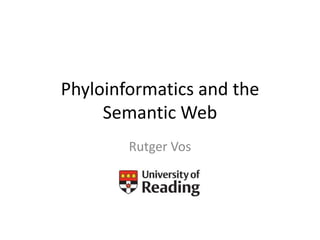
Phyloinformatics and the Semantic Web: Unlocking Evolutionary Data
- 1. Phyloinformatics and the Semantic Web Rutger Vos
- 2. Outline What is phyloinformatics and why should you care? How we got here and where we are now How the semantic web can help Projects that apply the semantic web to phyloinformatics Examples of linked data Where to next
- 3. What is Phyloinformatics? Phylogenetics: “The systematic study of organism relationships based on evolutionary similarities and differences.” Informatics: “The sciences concerned with gathering, manipulating, storing, retrieving, and classifying recorded information.”
- 4. Why should you care? Firstly, “Nothing in evolution makes sense except in the light of phylogeny” Surely, “gathering, manipulating, storing, retrieving and classifying” such information is worthwhile? But if that doesn’t convince you…
- 5. As a consumer of phylogenetic data The “New Biology” is coming: “Major advances will take place via integration and synthesis, rather than decomposition and reduction” (Committee on a New Biology for the 21st Century, 2009) Presumably, this will involve retrieving and classifying.
- 6. As a consumer of phylogenetic data Or maybe for you phylogeny is simply a nuisance: Functional prediction Comparative analysis Ortholog finding Etc. But it would still be nice to have that out of the way painlessly…
- 7. As a producer of phylogenetic data Many journals require proper storage of data described in a manuscript. Funding agencies require dissemination and sharing of research results.
- 8. The Past Everything was closed: Idiosyncratic, private data “pay-walls” Closed source software No accessible publishing medium
- 9. The Present Science is opening up: Open data Open access publishing Open source software Publishing is now accessible to everyone, online
- 10. Our current nightmare Documents, documents everywhere
- 11. The current web makes sense to us
- 12. But not to a machine
- 13. What was informatics again? “The sciences concerned with gathering, manipulating, storing, retrieving, and classifying recorded information.”
- 15. This is too hard O. R. P. Bininda-Emonds, M. Cardillo, K. E. Jones, R. D. E. MacPhee, R. M. D. Beck, R. Grenyer, S. A. Price, R. A. Vos, J. L. Gittlemanand A. Purvis, 2007. The delayed rise of present-day mammals. Nature 446: 507-512.
- 17. Instead of linked documents
- 18. A web of linked concepts
- 19. Concepts connected by statements
- 20. Concepts are defined in ontologies “An ontology is a formal representation of the knowledge by a set of concepts within a domain and the relationships between those concepts. It is used to reason about the properties of that domain, and may be used to describe the domain.”
- 21. Expressing concepts in data syntax
- 22. Concepts are linked Linked by statements called “triples” A triple is a statement subject predicate object Any part of a triple may have to be uniquely identifiable. For this we use URLs.
- 23. An applied example Triple 1 Subject: <http://example.org/data/tree1> Predicate: <http://example.org/terms/hasLikelihood> Object: 2342.323 i.e. -lnL(tree1) = 2342.323 Triple 2 Subject: <http://example.org/data/tree2> Predicate: <http://example.org/terms/hasLikelihood> Object: 2341.184 i.e. -lnL(tree2) = 2341.184
- 24. What’s the better tree? The ontology defines what a likelihood is and how to compare negative log likelihoods. Hence, automated reasoning can conclude that tree2 is the better tree.
- 25. URLs for phylogenetics PhyloWS doesn’t just provide an anchor to identify phylogenetic data, it also enables searching and retrieval.
- 27. TreeBASE
- 28. External links Study Taxon variant Taxon
- 29. A simple example TreeBASE maps to uBio using skos:closeMatch... …and uBio to ToL using gla:mapping
- 30. Another Example, UniProt sequences Standard tools can rewrite these linkout URLs Result is a corresponding list of UniProt records TreeBASE stores NCBI taxonomy identifiers
- 31. Another Example, Geocoding TreeBASE uses DarwinCore for lat/lon annotations
- 32. Many online data repositories
- 33. Challenges Fragile: many services offline in Japan Data gets bigger and bigger Many concepts not yet in ontologies Many data still “locked in” in publications
- 34. The Future
- 35. The cloud Software will be run on a number of “virtual” platforms (Amazon, Google apps, Yahoo) Data will be stored in the cloud (Big Table, FreeBase)
- 36. Interpreting locked in knowledge Text and images meant for humans are being processed by machines. Examples: Taxon name mining (BHL) Gene name and function mining Tree figure processing Automated annotation
- 37. Summary Phyloinformatics is moving from closed to open to linked data Concepts and syntax are increasingly formalized and machine readable Automated queries across integrated resources will enable synthetic research Still lots to do to deploy these technologies and unlock legacy data
- 38. Acknowledgements Thank you for your attention! Also, many thanks to: The Pagel lab at UoR The EvoInfo group Val Tannen Wayne Maddison William Piel Hilmar Lapp ArlinStoltzfus
Notas del editor
- Thank for invitation-Thank for showing up given other lecture-Introduce self-Talk title
- -Mention figure on the right
- -Mention dobzhansky
- Here’s an example that uses the Yahoo! Pipes tool to turns the list of NCBI taxon identifiers that TreeBASE stores for a given study into a list of all UniProt sequence records for those taxa.
- This example shows that with a minimal amount of JavaScript coding a google map can be added to a web page (first code block), and the taxa for a given study can be mapped onto it using the DarwinCore coordinate annotations that TreeBASE stores.
